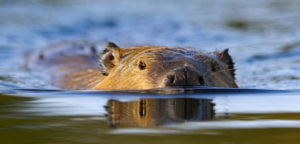The Gnawing Question of Saltwater Beavers

Most people associate the beaver, Castor canadensis, with fresh water—but it’s a coastal creature too. Photo by George Sanker/NPL/Minden Pictures
Scientists have long overlooked beavers in the intertidal zone. Now they’re counting on the freshwater rodents to restore Washington’s coastal ecosystems.
On a hunch, Groves, who works for the Progressive Animal Welfare Society’s Wildlife Rehabilitation Center just outside Seattle, drew a blood sample. The beaver’s sodium level was a shocking 183 milliequivalents per liter, far above the normal concentration, typically 130 to 150 milliequivalents per liter. The animal, she suspected, had ingested enough seawater to induce salt toxicity.
One salt-poisoned animal might be dismissed as a lone misguided mariner. Since that February 2016 case, however, Groves has seen four more sick saltwater beavers. Each one has suffered the same symptoms—lethargy, seizures, and catastrophic sodium levels—and none has survived more than 24 hours.
“They’re found on the shoreline, often covered in sand—they literally look like they were just pulled out of the ocean,” Groves says. She has started IV drips on her paddle-tailed patients, attempting to rebalance their salt levels without success. Groves has preserved tissue samples from all five victims in formalin; when she reaches a half-dozen, she plans to send them to a pathology lab, which, she hopes, will confirm her diagnosis of salt toxicity. “The pathologist gets samples submitted from all over the world, yet this was totally unheard of to him,” she says.
Once hunted almost to extinction for hat-making, beavers are now found in lakes across North America. Development of their coastal habitat, however, has mostly erased beavers from the intertidal zone. Video by Pond5
Groves’s experience sheds some light on a curious phenomenon—that North America’s most iconic freshwater rodents frequently take to the ocean. Although the peer-reviewed literature is scant, there are many anecdotal accounts of brave beavers venturing to sea. After the Argentine government attempted to jump-start a fur trapping industry by introducing the rodents to Tierra del Fuego in 1946, for instance, beavers swiftly spread throughout the archipelago, eventually crossing the Strait of Magellan to the Patagonian mainland—a voyage of at least 2.4 kilometers. On Isle au Haut, 11 kilometers off the Maine coast, rangers captured photos of a bedraggled beaver in 2014.
Yet beavers aren’t just coastal wanderers, they’re also residents—potential health consequences be damned. Greg Hood, senior research scientist at the Skagit River System Cooperative in Washington, says biologists have overlooked beavers in the state’s tidal shrublands, a liminal zone washed twice daily by the ocean. Until recently, Hood adds, estuarine beavers were considered bizarre anomalies, when they were considered at all. “You don’t find what you don’t look for,” he says.


